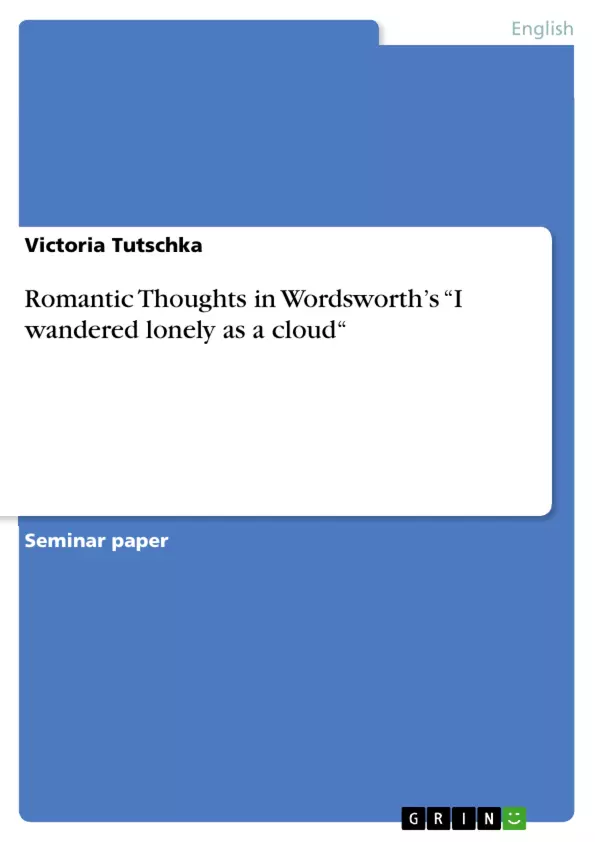William Wordsworth is known as one of the most influential English Romantic Poet.
Born in the year 1770 in Cockermouth, a beautiful landscape of the English Lake District, his whole life and work was characterized by the love of nature. Yet in his early ages he and his beloved sister Dorothy were taught important poetry of Shakespeare and Milton by their rarely present father. William was treated harsh by his relatives, when he had to stay at his mother’s home in Penrith as a teenager, but as a result he found comfort, tranquility and happiness in exploring the beauty of the nature on his own. In the first years of the 1790s he visited France and was impressed by the revolutionary force of the Republican movement. During his stay he fell in love with Annett Vallon, a French woman and got a daughter with her. Due to the developing British-French war, he had to leave France soon and saw Anett and their daughter seldom again, but always stayed in contact with them. In 1793 Wordsworth wrote the first version of the so-called manifesto of English Romantic Criticism: the ‘Preface to Lyrical Ballads’ with “experimental“ poems. Together with his friend, the poet Samuel Taylor Coleridge, he produced the first of four editions of ‘Lyrical Ballads’ in the year 1798. In this central Romantic work, he defines poetry as " the spontaneous overflow of powerful feelings from emotions recollected in tranquility.".
Table of Contents
- Wordsworth and Romanticism
- Central meaning, content and structure of the poem
- The image of nature and the universe
- Religious feelings, gender and the sublime
- Conclusion
Objectives and Key Themes
This paper aims to analyze William Wordsworth's poem "I Wandered Lonely as a Cloud," exploring its central themes within the context of Romanticism. The analysis will examine the poem's structure, imagery, and meaning, connecting them to broader Romantic ideals.
- Wordsworth's Life and the Romantic Movement
- The poem's imagery and symbolism, particularly concerning nature
- The expression of emotion and the sublime in the poem
- Pantheistic elements within Wordsworth's work
- The role of memory and imagination in shaping experience
Chapter Summaries
Wordsworth and Romanticism: This chapter introduces William Wordsworth as a key figure in the English Romantic movement. It details his life, highlighting his early exposure to nature and the influence of his family and experiences, including his time in France and his relationship with Annette Vallon. The chapter then defines Romanticism as a reaction against Enlightenment rationalism, emphasizing its focus on emotion, imagination, and the natural world. It contrasts the Romantic emphasis on subjective experience with the Enlightenment's focus on objectivity and reason, and it explores the Romantic interest in simple people and settings, linking these preferences to a rejection of the 'disease' of scientific objectivity. Finally, the chapter discusses the changing conception of religion during the Romantic period, specifically mentioning Wordsworth's pantheistic leanings and its implications for his worldview.
I wandered lonely as a cloud: This section presents the full text of Wordsworth's poem, "I Wandered Lonely as a Cloud." The inclusion of the poem itself serves as a crucial element for the subsequent analysis, providing the primary text for detailed examination in later chapters. The poem's simple yet evocative language, its focus on nature and personal experience, and the shift between the initial encounter with the daffodils and the later recollection of the scene lay the groundwork for the themes that will be explored.
Keywords
William Wordsworth, Romanticism, "I Wandered Lonely as a Cloud," nature, emotion, imagination, sublime, pantheism, memory, poetry, Lyrical Ballads.
Frequently Asked Questions: Analysis of William Wordsworth's "I Wandered Lonely as a Cloud"
What is the purpose of this document?
This document provides a comprehensive preview of an academic analysis of William Wordsworth's poem, "I Wandered Lonely as a Cloud." It includes a table of contents, objectives and key themes, chapter summaries, and keywords, offering a structured overview of the analysis.
What are the key themes explored in the analysis?
The analysis explores several key themes within Wordsworth's poem and the broader context of Romanticism. These include Wordsworth's life and its influence on his work, the poem's imagery and symbolism (especially concerning nature), the expression of emotion and the sublime, pantheistic elements, the role of memory and imagination, and the poem's structure and meaning.
What is covered in the chapter on "Wordsworth and Romanticism"?
This chapter introduces William Wordsworth within the English Romantic movement, detailing his life, influences (including his family, experiences in France, and relationship with Annette Vallon), and the key tenets of Romanticism. It contrasts Romanticism with Enlightenment rationalism, highlighting the Romantic emphasis on emotion, imagination, nature, and subjective experience. It also discusses the changing conception of religion during the Romantic period, specifically mentioning Wordsworth's pantheistic leanings.
What is the role of the poem itself in the analysis?
The full text of "I Wandered Lonely as a Cloud" is included in the analysis. This allows for a detailed examination of the poem's language, imagery, and structure, providing the primary text for the subsequent thematic exploration.
What are the main keywords associated with this analysis?
Key words include: William Wordsworth, Romanticism, "I Wandered Lonely as a Cloud," nature, emotion, imagination, sublime, pantheism, memory, poetry, and Lyrical Ballads.
What is the overall structure of the analysis?
The analysis is structured into chapters covering Wordsworth and Romanticism, a presentation of the poem itself ("I Wandered Lonely as a Cloud"), and further chapters delving into specific aspects of the poem's themes and structure (such as imagery of nature, religious feelings, and the sublime).
For whom is this document intended?
This document is intended for academic use, supporting the structured analysis of themes within Wordsworth's poem. It is intended to provide a clear and concise overview of the academic work.
- Citation du texte
- Victoria Tutschka (Auteur), 2009, Romantic Thoughts in Wordsworth’s “I wandered lonely as a cloud“, Munich, GRIN Verlag, https://www.grin.com/document/139441



